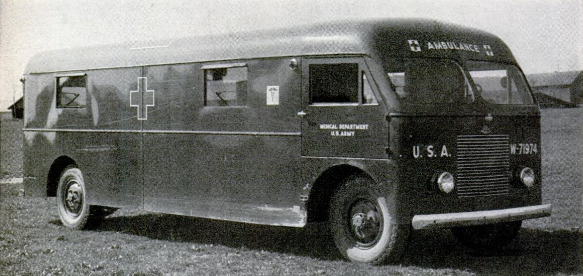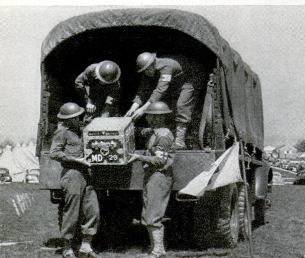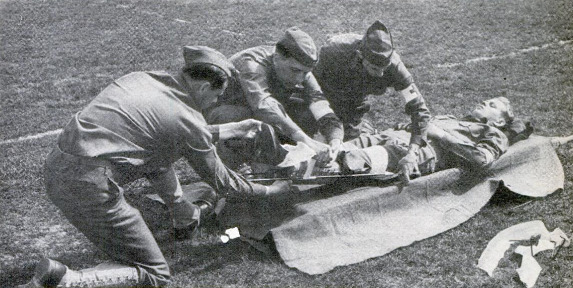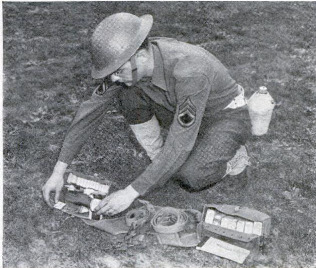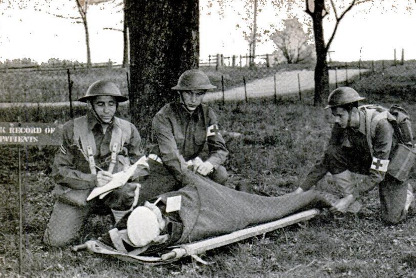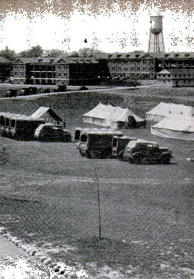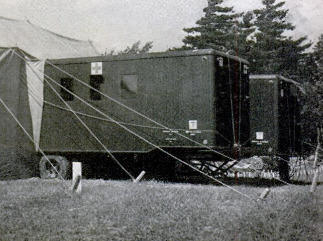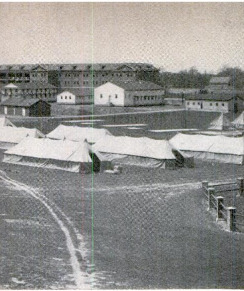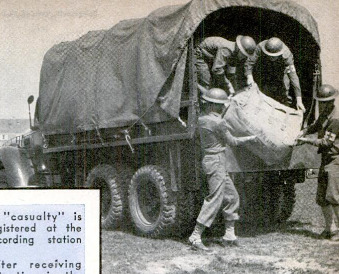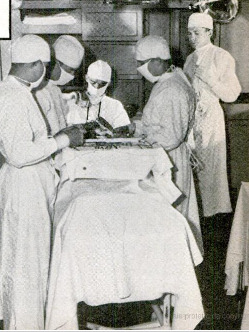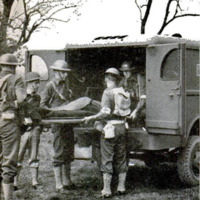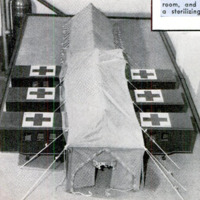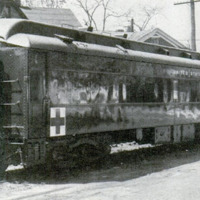-
Title (Dublin Core)
-
Motorizing the medical cars: keeps peace with the new army
-
Article Title and/or Image Caption (Dublin Core)
-
Title: Motorizing the medical cars: keeps peace with the new army
-
extracted text (Extract Text)
-
TO THE same all-out degree that Ameri-
can industry is supplying the sinews,
bones, and blood to the nation's fighting
strength, it is lending its technique and
talents to the mechanical development of our
Army's Medical Department which, under
the urgency of modern warfare, has become
a highly flexible and fast-moving branch of
the military service. With equipment rang-
ing from the new, compact mobile surgical
hospital, which is moved in sections and can
be set up directly behind a fighting front, to
plastic splints for shattered bones, the
Medical Corps, one of the several corps of
the Medical Department, is making ready
to keep pace with the swift and intricate
processes of war as it is fought in the year
1041.
wounded soldiers, knowing that nothing
could be done for them, prayed for death.
As late as the seventeenth century, men were
assigned to seek out the severely wounded
and release them from their agony.
Today, by reason of the advances of
science, medicine, and industry, together
with the organization of the Medical Corps
as an integral part of every fighting unit,
a gravely wounded man has the almost
certain knowledge that in a very little while
help will come to him. Such knowledge
sustains morale.
Each triangular infantry division in the
Regular Army has a medical battalion, and
each square division has a medical regi-
. ment. The medical battalions or regiments
consist of collecting, ambulance, and clear-
ing units.
Each regiment and separate unit in the
entire Army has a medical detachment.
Each infantry battalion has a medical de-
tachment of two medical officers and 27
enlisted men. Eight of these men are com-
pany “aid men,” two attached to each
company; ten are litter (stretcher) bearers,
and the remainder are members of the
battalion aid-station group. The medical
officers and men move into a zone of action
with the fighting troops.
Lest anyone think that being in the
Medical Corps is a soft job, let him consider
that the rate of mortality among medical
officers in the World War was higher than
It was not so very long ago that badly
that for officers in the aviation, cavalry,
engineers, ordnance, or quartermaster
branches. It was exceeded only among
officers in the infantry, signal corps, and
artillery.
When a soldier is wounded on the field
of battle, the first to reach him will be one
of the aid men attached to his company.
This aid man carries a kit consisting of an
expandable canvas pouch. In the right-hand
pocket of the kit are: 2 ounces of aromatic
spirits of ammonia USP; 1 spool of 1-inch
adhesive plaster; 1 bandage scissors; 2
cards of medium-size safety pins; 2 boxes
of fodine swabs, 6 swabs to a box; 12 3-inch
compressed gauze bandages; 3 triangular
bandages; 1 enlisted men's instrument case,
containing 1 hemostatic forceps and 1 pair of
double-blunt scissors; 1 metal container for
aspirin and other drugs; and one flask
with a cup.
In the left-hand pocket are: 1 pencil; 8
packages of small first-aid bandages; 2
litter strap kits, for use with stretchers;
1 book of emergency medical tags, used to
tag the wounded and dead. Before battle
the aid men expand their pouches as far as
possible and stuff them with extra bandages.
The aid man gives what help he can to
the wounded fighter. Next, if he is unable
to walk, the litter bearers move him to the
battalion aid station, which is situated in
the front-line area. Here he is
examined and given prompt
emergency treatment. From
the aid station he is taken by
litter or ambulance to the col-
lecting station about a mile
from the front line. Again he
is examined, treated, and pre-
pared for evacuation to the
clearing station, about five
miles from the front. Here
minor cases are separated
from serious ones. If the
wounded man if suffering from
a minor wound or from slight
shell shock or gas poisoning,
he is treated here and sent
back to duty.
If the wounded soldier is
injured seriously enough to
require hospitalization, it is
often possible at the clearing
station to change him from
a lying or litter patient to a
sitting patient. A sitting
patient takes up only about
a third as much room in the
ambulance as a litter patient.
The new 114-ton cross-coun-
try field ambulances, for ex-
ample, have room for ten
sitting patients but for only
four litter patients. The advantage is clear.
If the casualty is an immediate surgical
case, he is rushed to the mobile surgical
hospital which usually is set up in the
vicinity of the clearing station. Or, if
seriously wounded but not an emergency
surgical case, he would be taken to an
evacuation hospital equipped with all facili-
ties for modern surgical and medical treat-
ment. The final step would be to move him
out of the combat zone to a general hospital.
At the Medical Field Service School, at
Carlisle Barracks, Pa., tests are being con-
ducted on two types of mobile surgical hos-
pitals. The first type consists of units made
up of semi-trailers, tractor-drawn.
Some of these trailers are made into
operating rooms, some into X-ray rooms,
supply rooms, sterilizing rooms. Others be-
come moving laboratories, or power units
to supply electric light and hot water and
heated air, or to carry water tanks.
When the mobile surgical hospital is set
up, a huge tent, divided into two sections,
is erected. In the main part, known as the
amphitheater, the operations take place.
Into the amphitheater tent are backed
four trailer operating rooms, a trailer X-ray
room, and a trailer sterilizing room. The
rear doors are opened and the mobile surgi-
cal hospital is ready to function. Outside
the tent are grouped two 2 1/2;-ton power-
plant trailers, which supply electric current
generated by gasoline engines; two 2 1/2-ton
cargo trucks or trailers, and a 2 1/2"-ton truck
carrying a water tank.
The operating-room trailers are equipped
for heat and ventilation and each one has
three overhead operating lights, cabinets
with special instruments, an anesthesia ma-
chine, and a 120-gallon water pressure tank.
The hospital, it is conservatively estimat-
ed, can handle 80 major operations every 24
hours. In the rear tents 100 or more beds
may be set up, where the patients are cared
for until they can be moved.
The second type of mobile surgical hos-
pital unit under consideration at the Car-
lisle Barracks is composed of busses, rather
than semi-trailers. A bus-type ambulance,
a 10,000-pound, front drive vehicle, is now
undergoing tests. It can carry 20 sitting
patients or 12 litter patients. The Medical
Corps is considering turning some of these
busses into operating, X-ray, and other
units of the mobile hospital.
A new cross-country ambulance, made by
Bantam, Dodge, and Ford, is called by offi-
cers the most efficient model ever developed.
This is a four-wheel-drive, 1}-ton vehicle
with high chassis and powerful springs.
Also under development is a hospital
train consisting of reconditioned Pullman
cars for transporting casualties to fixed
hospitals in the rear. This train, according
to present plans, is to be equipped with a
heating unit, operating room, kitchen, steri-
lizing machines, and 3 tiers of bunks.
Airplane ambulances are being tested at
the School of Aviation Medicine at Ran-
dolph Field, Tex. In the larger air ambu-
lances there are emergency operating rooms.
-
Contributor (Dublin Core)
-
John Watson (article writer)
-
Language (Dublin Core)
-
Eng
-
Date Issued (Dublin Core)
-
1941-08
-
pages (Bibliographic Ontology)
-
108-112
-
Rights (Dublin Core)
-
Public domain
-
Archived by (Dublin Core)
-
Sami Akbiyik
 Popular Science Monthly, v. 139, n. 2, 1941
Popular Science Monthly, v. 139, n. 2, 1941

